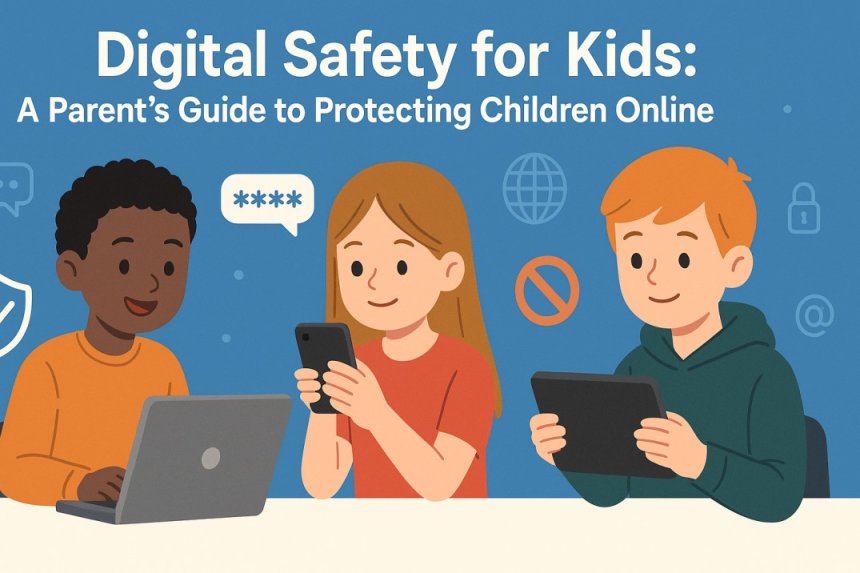Growing Up Connected: Teaching and Parenting in the Age of AI
Artificial intelligence is no longer a distant prospect. It is gradually becoming a daily reality in our homes, educational systems, and schools. AI offers tools that can personalize learning, create adaptive learning platforms, provide diverse assessment methods, and much more.
The internet is today’s playground, and increasingly, it’s where kids turn not just for fun, but for emotional support.
Recent studies confirm that when used thoughtfully, AI can reinforce rather than weaken our parenting or teaching mission. Research shows that digital tools help create more inclusive learning environments, support children with diverse needs, and free up time for adults to focus on deeper and more meaningful interactions with children, something that they need now more than ever. In this way, technology becomes an ally in cultivating equity and creativity, rather than being a distraction from them.
However, there are important boundaries to recognize. AI cannot replace the emotional bonds at the core of learning and upbringing, such as trust, care, and encouragement. Parenting and teaching are not only about transmitting knowledge, but about daily practices of listening, guiding, and modeling integrity. Without this relational dimension, education and upbringing may lose their transformative power.
This is why our role as adult models is so crucial. Beyond academic knowledge, we pass on values that shape lives and communities. Each day, we can remind children of the importance of upholding human rights, respecting diversity, and offering generosity and assistance to other people who may feel vulnerable. We can encourage them to show compassion, celebrate cooperation over competition, and understand that the school and their home are the most important places for helping them become better human beings.
As parents, we have to remember that setting healthy boundaries around screen time helps children find balance between digital and offline worlds, while shared activities such as reading, playing, and family conversations remind them that human presence is irreplaceable. Moreover, by exploring digital tools alongside their children, parents can model curiosity, critical thinking, and responsible use of technology, transforming AI into a subject of dialogue rather than a source of silent consumption.
Equally important is encouraging open discussion about how children use AI for learning, gaming, or communication, so they can reflect on ethical choices and emotional impact with the support of a trusted adult. In this way, parents foster not only digital literacy but also moral awareness. Most importantly, they can protect family spaces, such as meals, leisure, or bedtime, from digital interruptions, ensuring that love, listening, and connection remain at the heart of everyday life. By staying in dialogue with teachers and schools, parents can also extend positive practices from the classroom into the home, creating a unified message about the role of technology as a tool that must always serve and never replace empathy and fairness.
Starting digital lives early
Children are online more than ever, but what’s more striking is how early digital life begins. Norton found that while today's parents received their first mobile device at age 23 on average, their children are getting connected at just 11 years old. This 12-year gap represents a fundamental shift in how childhood online unfolds.
AI enters the family digital toolkit
Artificial intelligence is reshaping how children learn, create, and interact online, with nearly half (48%) currently using ChatGPT and 30% using Google Gemini globally.
While 43% of parents around the world believe AI benefits children's learning and creativity – though this varies significantly by gender and generation – the emotional component of AI interaction deserves special attention as kids are turning to AI for emotional support. This data highlights the importance of healthy relationship building and emotional development within families, especially in an AI-forward world.
Understanding cyberbullying: the numbers tell a story
While cyberbullying isn’t new, it’s still crucial for families to discuss with their children as they start navigating digital spaces. Parents globally report that cyberbullying affects more than 1 in 8 (13%) of kids, with numbers rising to nearly 1 in 4 (24%) in the US. Unsurprisingly, parents around the world said most of this harassment took place on social media – with Facebook and Instagram leading the way, and 39% of perpetrators identified as classmates or peers.
The screen time management challenge
While the majority of parents actively manage their children's screen time, enforcement remains challenging. Despite their efforts, digital-savvy kids often stay one step ahead. Nearly 1 in 3 (29%) of children find ways around screen time limits and tell their parents about it, while another 23% bypass controls without disclosure, and parents discover these workarounds independently. Overall, these trends point to a growing need for open communication and digital literacy within families – moving beyond just screen time restrictions or parental controls.
Building your family's Cyber Safety Strategy
Effective online safety isn't about restrictions – it's about preparation and communication. Here's how families can build robust digital safety practices:
Start with open conversations
Create judgment-free spaces for discussing online experiences. Nearly half of children seek parental guidance during challenging online interactions, indicating they want support when problems arise.
Regular check-ins work better than crisis-driven conversations. Ask about:
- Interesting things they've seen online
- Friends they've made in digital spaces
- Confusing or uncomfortable interactions
- New apps or platforms they want to try
How Parents Can Navigate AI with Confidence
AI is here to stay, and the only way to make it a part of our lives in a balanced manner is to develop a healthy relationship with it. As parents, we don’t have to be AI experts to make informed decisions. Here are some practical strategies for fostering a balanced and mindful approach to AI-powered parenting:
1. Educate Yourself and Your Children
Understanding AI helps you guide your children more effectively. Resources like That’s AI provide accessible explanations about AI's impact. Encourage kids to ask questions and answer them in an age-appropriate manner. For instance, your answer to the question 'Who is Siri?' would be significantly different when it comes from a preschooler than an adolescent. We must teach our children to think critically about how AI works.
2. Maintain Open Conversations
Talk to your children about AI's presence in their lives. This might not be applicable if your child is still in preschool and if you have successfully restricted AI usage. But for grown-up kids older than the preschoolers, who are using AI, ask them about the apps they use, the content they watch, and how they feel about AI-driven experiences. This builds awareness, creates openness, and helps children develop a responsible digital mindset. Remember not to sneak through!
3. Set Digital Boundaries
This is particularly important as it requires us, parents and adults, to change our habits. We must start with ourselves in creating a digital boundary. If we are hooked on our phones, so will our children be. In addition, we can set some family guidelines for AI usage, like limiting screen time, designating tech-free zones (e.g., during meals and before bedtime), and monitoring online activity.
4. Explain the journey of AI
Teaching children to question AI-generated content fosters independent thinking. We must make it evident to the next generation that it lies upon us, the creators of AI, to use AI mindfully. Our children need to understand that it is the dedication and thinking of hundreds and thousands of generations of our species that have led us to discover AI. Otherwise, it might be really difficult for our children to understand the journey of AI that will lead to unscrupulous usage in their growing years, which will prove to be a disadvantage for them in the long run.
Encourage them to ask questions and educate yourself to be able to answer them!
5. Encourage a Balanced Tech-Life Integration
For children below the age of seven years, the only balance that we can discuss is a gadget-free environment. No amount of digital exposure is good. We have evolved, as a species, amidst nature, and the first seven years need to be nurtured in a nature-inspired environment. For children who are a little more grown-up, AI should complement rather than replace real-life experiences. We still have to encourage outdoor play, face-to-face interactions, and hands-on creative activities. When it comes to school lessons and homework, AI-powered learning should be balanced with traditional books, storytelling, and unstructured playtime.
6. Advocate for Child-Safe AI
This is probably a bit Utopian, but we must keep the intent. We, as the forbears of AI, must actively support companies and policies that prioritize ethical AI development for children. This can be done by choosing apps and platforms that commit to responsible AI practices, ensuring safety, fairness, and privacy protection, which means we have to get into the habit of reading the Terms & Conditions before exposing our children to any AI-driven apps or programs.
Looking Ahead: Raising AI-aware Children

AI is here to stay, and its role will only expand in the coming years. By being mindful and fostering a proactive, informed, and ethical approach to technology, we can ensure that our children grow up as responsible digital citizens who understand AI’s benefits and limitations.
As parents, our role is to guide our children in using AI as a tool for learning, creativity, and connection—without allowing it to define their experiences. By staying informed and engaged, we empower them to navigate this evolving landscape with confidence, curiosity, and integrity.
Share
What's Your Reaction?
 Like
0
Like
0
 Dislike
0
Dislike
0
 Love
0
Love
0
 Funny
0
Funny
0
 Angry
0
Angry
0
 Sad
0
Sad
0
 Wow
0
Wow
0
















